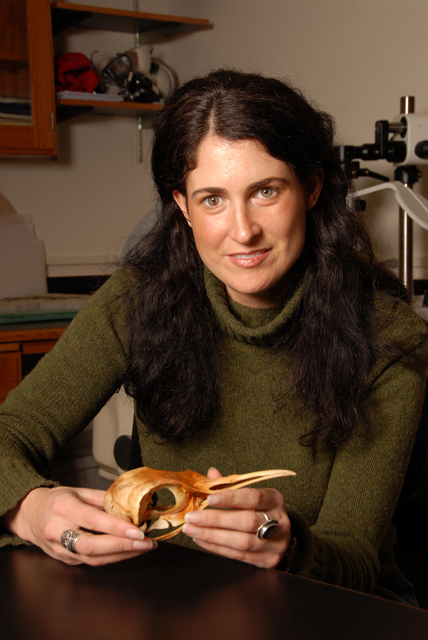Antarctic bird nest?Discovery of avian fossils suggests Antarctica may have been origin of modern speciesPosted June 5, 2009
Julia Clarke After all, about five years ago, she and her U.S. and Argentine colleagues found proof from a rock specimen, which contained avian vertebrae and pelvic bones among other bits of skeleton, that close relatives of at least one order of modern birds co-existed with dinosaurs. The discovery of the new species, Vegavis iaai, collected in 1992 by scientists from Argentina on Vega Island and re-examined by Clarke and her U.S. and Argentine team more than a decade later, using high-resolution X-ray computed tomography (CT) technology, resulted in a paper in the journal Nature in 2005. Based on the data, Vegavis iaai fell within the order Anseriformes, which includes ducks, geese and swan. Vegavis lived more than 65 million years ago, well before Antarctica turned into an icehouse. It also existed just before the mass extinction that swept the dinosaurs from the Earth along with up to three-quarters of all species. The find was important because it offered some of the best fossil evidence to date that linked modern bird divergence, the spread of today’s species, before the K-T boundary — when geologic time turned the page from the Cretaceous to the Tertiary period after the mass extinction. On one side of the controversy are scientists who argue that molecular evidence and modern distribution of living bird groups suggest that their ancestors existed alongside non-avian dinosaurs well before the K-T extinction, perhaps tens of millions of years earlier. Others have claimed the fossil record shows no real evidence of living bird lineages in the Cretaceous. Only after the extinction, they say, did modern bird evolution take flight. “It’s still really extraordinarily contentious five years later what lineages are present in the Cretaceous prior to the K-T boundary,” said Clarke, associate professor in the Department of Geological Sciences at the University of Texas at Austin Clarke and her colleagues believe they may find additional information on what lineages date before the K-T boundary by examining additional fossils collected from Antarctica over the last 20 years. Growing evidenceClarke is the principal investigator (PI) on a Small Grant for Exploratory Research (SGER) from the National Science Foundation (NSF) 
Photo Credit: North Carolina State University
Julia Clarke holds a penguin skull related to separate avian fossil research.
“The partial skeletons … from Antarctica are the best candidates for being part of that extant radiation,” Clarke said. “The nice thing about getting this team together is we’re sharing information, we’re sharing data, and hopefully coming to a consensus view of what diversity is represented,” Clarke said. Her co-PI on the project is Judd Case, dean of Eastern Washington University’s College of Science, Health and Engineering Case said the material from those finds has further bolstered the hypothesis of the earlier radiation of modern birds, with at least four lineages emerging before the K-T extinction based on the evidence the scientists are assembling. “We’ve got a good amount of material to make the judgment,” he said. “We’ve got good documented, late Cretaceous deposits,” including specimens from the major clade, or group, Neoaves. “The fossil data, along with the molecular data, continue to point to this older origination, and it’s providing a location where this … may have occurred,” Case said.1 2 Next |



For USAP Participants |
For The Public |
For Researchers and EducatorsContact UsU.S. National Science FoundationOffice of Polar Programs Geosciences Directorate 2415 Eisenhower Avenue, Suite W7100 Alexandria, VA 22314 Sign up for the NSF Office of Polar Programs newsletter and events. Feedback Form |


